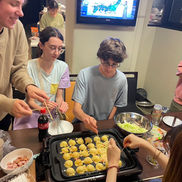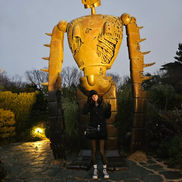Allison Contois
Study Abroad
This page shows my reflections from my experiences abroad, as well as pictures from my time in Japan.
After my sophomore year at Clemson University, I had the opportunity to study abroad for both the Summer 2023 semester and the Fall 2023 semester. During the summer, I attended a Clemson program led by the Japanese professors. For the first ten days, we toured various prefectures of Japan and learned more about the culture. Then, we spent a month studying at Kansai Daigaku. After the end of my time at Kansai Daigaku, I briefly returned to America before flying back to Japan and starting my full-length semester at Meiji Gakuin University in Yokohama. Despite the differences in lengths of the two programs, both taught me different skills, and I value them equally.
My first experience abroad was with the help of two of Clemson University’s Japanese professors. As someone who had never flown except for a single round trip at the age of six, I was extremely nervous about travelling to a foreign country. Being able to rely on my professors helped me get my footing and build confidence before I went out on my own. For the first ten days of the program, we traveled as a group. Every couple of days, we packed out things and took a Shinkansen to a new, exciting prefecture. We started our trip in the old capital of Japan, Kyoto. There, we had the opportunity to engage in cultural activities such as visiting Fushimi Inari while wearing Kimono, praying at shrines, getting fortunes, and learning how to navigate a train station. After that, we moved on to Kanazawa, Takayama, Gero, Himeji, and Hiroshima. We had opportunities to experience many historical sites, such as Himeji Castle and the Atomic Bomb museum. These trips let us see into the historic culture of Japan, from the Shogun era to World War II. We also had the opportunity to stay at Gero Onsen and experience Japanese Onsen Culture. Many of us were a bit shy about the concept of public bathing, but after giving it a try I grew to really enjoy onsen.
My favorite of the places we visited was Shirakawa-go. Shirakawa-go is a preserved Japanese village that is not reachable by train. We arrived after a roughly 2-hour bus ride. All of the buildings and architecture was still in traditional Japanese style, and it offered a unique insight compared to the skyscrapers of the big cities. I remember that despite my initial fear over how people from smaller cities with less tourists may react to us, I found that the majority of my experiences were positive.
After the initial ten days of traveling, we settled into the dorms at Kansai Daigaku. After being able to rely on others in my group who were much better at Japanese than I was, I was suddenly on my own in a dorm group with no English speakers. Within the first few hours of moving in, I heard a knock at my door. It was my dormmate, Mana, who came to introduce herself and welcome me in. Mana was from Mainland China but was fluent in Japanese. This meant that our one shared language was Japanese, and I had no choice but to communicate in Japanese. At first, I stumbled through sentences. However, she was always very patient with me and eventually I was able to hold conversations for hours at a time. Despite the language barrier, she helped me navigate culture shock in Japan and explained some unwritten rules that had surprised her when she first arrived. For example, she told me that in Tokyo, you are supposed to stand on the left side of the escalator and let people pass on the right. However, in Osaka (where we currently were) it was the opposite. She helped me both get used to the daily life in Japan and to learn how to use the Japanese language casually with friends.


After a brief return to my home state, I returned to Japan. This time, I was much more prepared. I navigated customs by myself for the first time and was able to offer some advice to friends who were in Japan for the first time. Unlike my summer semester, we settled into the dorms and school rhythm immediately. One aspect of Japanese culture that still vexed me was public transportation. I grew up in an area of the United States with very little public transportation. In Japan, I struggled to navigate bustling train stations and crammed buses. While I enjoyed public transportation immensely, it took me quite a while before I could use it naturally.
When I first arrived to my Japanese class at Meiji Gakuin University, I had some concerns. I read on the syllabus that that particular class was recommended for people with at least 6 semesters of college-level Japanese classes, and at the time I only had 2 semesters plus the short experience at Kansai Daigaku. I told my professor, Shimizu sensei, that I wasn’t sure I was good enough to be in that class. She encouraged me to try for a week or so, and then if I still felt like I should drop down a level then I could do that.
After a week, I decided that even if it was a challenge, I was going to try my best to stay in that level. I owe a lot of my progress to my professors, who always made sure I understood the lessons and were patient with me when I struggled to express my thoughts properly. Within my class, there was a roughly even split of American students and Chinese students. Once again, our common language was Japanese, so when communicating with the Chinese students I had to use Japanese. Additionally, we were not allowed to speak in our native languages during class times. This meant that even with people from my own home country, we had to step outside our comfort zones and speak in Japanese. At the end of the semester, I handwrote both my Japanese professors notes expressing my gratitude for helping me step out of my comfort zone.
During my fall semester, I was able to experience the more day-to-day aspects of life in Japan. From figuring out how to pay bills to having to fill out forms at the ward office, I learned many practical life skills. Additionally, I frequented a local island named Enoshima, often by myself, despite the fact that I was initially afraid to travel very far on my own. My time in Japan didn't just help me with my language and cultural competency, but I developed a new sense of independence and confidence in myself.
Through my experiences abroad, I was able to attain a deeper understanding of both the Japanese language and culture. Without my time in Japan, as well as the friends I made there, I would not have been able to place first in the Clemson University Speech contest in Spring of 2025. Not only has my confidence in my speaking ability increased, my independence and belief in myself has allowed me to step out of my comfort zone even back in the United States. Despite sitting in my first speech contest in 2023 and thinking I would never be able to reach the same skill level as the other participants, my time in Japan showed me that all I needed was a little faith in myself. I am eternally grateful to have been able to study abroad and look forward to my next chance to visit Japan.







